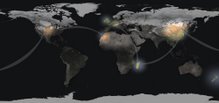 My point, such as it is, comes with a small Mongolian retrospective triggered by a cave we went into last weekend. Behind the crew destroying and replacing the impenetrable cave gate at Devilstep in the Sequatchie Valley, there is Native American art of a kind I've never seen. Eastern woodlands indians, more than a thousand years ago, made these images. They created shapes in the glow of flaming cane bundles. We got in with light-emitting diodes powered by metal ion canisters. Someday someone will say 'dang, they went underground with just a headlamp.' It wasn't the smoke of accidental blowtorch bat barbecue that made the cave gnarly.
My point, such as it is, comes with a small Mongolian retrospective triggered by a cave we went into last weekend. Behind the crew destroying and replacing the impenetrable cave gate at Devilstep in the Sequatchie Valley, there is Native American art of a kind I've never seen. Eastern woodlands indians, more than a thousand years ago, made these images. They created shapes in the glow of flaming cane bundles. We got in with light-emitting diodes powered by metal ion canisters. Someday someone will say 'dang, they went underground with just a headlamp.' It wasn't the smoke of accidental blowtorch bat barbecue that made the cave gnarly.In Mongolia, I went on an extended horse trip alone with a small compliment of gear. I didn't cover a whole lot of ground, but it was a solid journey in my book. Even though Mongolia was incredibly vast and foreign, there was something comfortable about it. Maybe it was because I was hardly ever more than a day's ride from anyone's yurt, and that yurt would be guaranteed to have food and hospitality. The land of the Mongols is lived on, and has been for longer than anyone can remember. You can't find grass that hasn't been grazed by someone's domestic animal. It is wild, but it is near.
 Those same people who had known Asia for thousands of years are the same people who wandered into North America. The same line of people wandered into Devilstep cave and made art. North America was new. North America is wild. People have only been on this continent for 15,000 years, maximum. Those people aren't talking, and our line has only been here the scarce part of 500.
Those same people who had known Asia for thousands of years are the same people who wandered into North America. The same line of people wandered into Devilstep cave and made art. North America was new. North America is wild. People have only been on this continent for 15,000 years, maximum. Those people aren't talking, and our line has only been here the scarce part of 500.Why is that significant? It means that even if it is home, and if it is covered by roads, we are farther from this continent, more susceptible to this wilderness than to any other, with the exception of South America. But I haven't really been there, so I can't comment. Sure, we've mapped this place. But if you want to measure journeys, you'll have to go farther back in time.


No comments:
Post a Comment